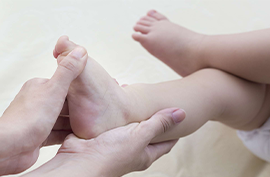CTEV / clubfoot Management

Clubfoot, clinically known as Congenital Talipes Equinovarus (CTEV), presents a challenge in pediatric orthopedics but is effectively managed through a comprehensive treatment approach. Initial diagnosis involves a thorough physical examination to assess the severity and determine the appropriate treatment plan. Non-surgical methods such as the Ponseti method, a gold standard globally, involve gentle manipulation and serial casting to gradually correct the foot deformity. This technique has shown remarkable success rates, especially when started early in infancy. Following the correction phase, maintenance involves a period of bracing to prevent relapse and ensure the foot maintains its corrected position as the child grows.
In cases where conservative methods are insufficient, surgical intervention may be necessary, typically involving soft tissue release and occasionally bony procedures to achieve full correction. Advances in surgical techniques have significantly improved outcomes, reducing recovery times and improving long-term function. Post-surgery, rehabilitation and ongoing monitoring are crucial to monitor growth and address any recurrence or functional issues promptly.
The management of CTEV not only focuses on physical correction but also emphasizes psychological and social support for families, ensuring they understand the treatment process and are actively involved in the care of their child. Early intervention and a multidisciplinary approach involving orthopedic surgeons, physiotherapists, and pediatricians are key to achieving optimal outcomes and improving the quality of life for children affected by clubfoot.


